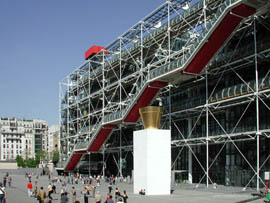
Centre Pompidou - an uninterrupted space for art woven with pipes
 |
Beaubourg looks more like a factory than a cultural center - brightly colored pipes and tubes run outside along the walls like the "technical guts" of the object. The building appears as if it is turned inside out: escalators, elevators, plumbing and air conditioning, as well as the entire structure of the building - massive steel supports - are located outside the envelope of the structure. Inside, a space free from interruptions was thus created. However, behind glass and steel hides not only a museum with an impressive collection of twentieth-century visual art but also a center for industrial design, a film museum, and concert halls.
With a proposal for the construction of an original cultural center, where contemporary art collections could be housed and where a public library would be located, films screened, music played, and theater performed, came the then French President Georges Pompidou in 1969. The international competition ultimately yielded victorious architects who rejected all traditional arrangements and prioritized creating sufficient space - Renzo Piano, Richard Rogers, and Gianfranco Franchini. Construction began in 1972 and lasted five years.
One of the most popular Paris landmarks has not had an easy life during its (not long for a building) existence. Many initially perceived it as an ugly blot on the historical center of the French capital. Critics talked about its futuristic unattractiveness, mocking the colorful pipes on the surface of the building. Nevertheless, the unusual building in the Marais district, with a magnificent view of Paris, became an integral part of the Parisian scenery. And its popularity among visitors exceeded expectations so much that just twenty years later Beaubourg was so worn out that it earned an expensive and 27-month-long reconstruction. Beaubourg was visited by four times the expected five thousand visitors daily. Today, their annual number reaches a remarkable seven million.
Paradoxically, Georges Pompidou posed the project’s authors a question: "Are you aware that this building must last for five hundred years?", and the answer was: "Of course, Mr. President."
The reconstruction brought not only technical renewal but also a new arrangement of the entire center. The total area of all floors now exceeds 100,000 square meters. The most famous are the fourth and fifth floors hosting the National Museum of Modern Art, which has 14,000 square meters and presents about 1,400 (out of a total of 59,000) artworks, while before the reconstruction it was around 800. Beaubourg features cinema halls, galleries for children, a popular library, café, restaurant, and spaces for temporary exhibitions. Children can enjoy playing with colors, fabrics, and other materials. Their creations then form the so-called children's gallery. Street artists, organ grinders, and musicians are also an inseparable part of the Pompidou Center.
As the first cultural institution in the world, the Pompidou Center boasts the ISO 9000:2000 quality certification for its management and artistic management.
For Richard Rogers, now Lord Rogers of Riverside, one of the fathers of high-tech architecture, the Centre Pompidou represented a successful milestone in his further career. He has cultural and industrial buildings to his credit in France, the USA, and his native England - such as the Lloyd's bank skyscraper or the giant London Millennium Dome stadium. His design for the new terminal at Madrid airport was declared the best British building of the year last year.
The English translation is powered by AI tool. Switch to Czech to view the original text source.
2 comments
add comment
Subject
Author
Date
slavna-neslavna "chobotnice"
Simona
25.02.08 08:07
Re Simona
25.02.08 09:25
show all comments










